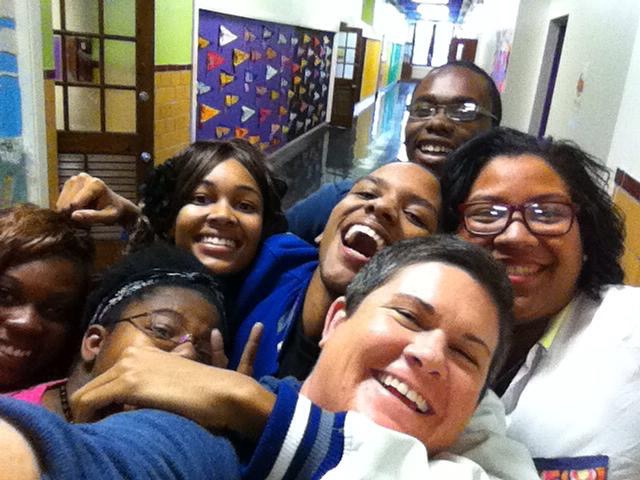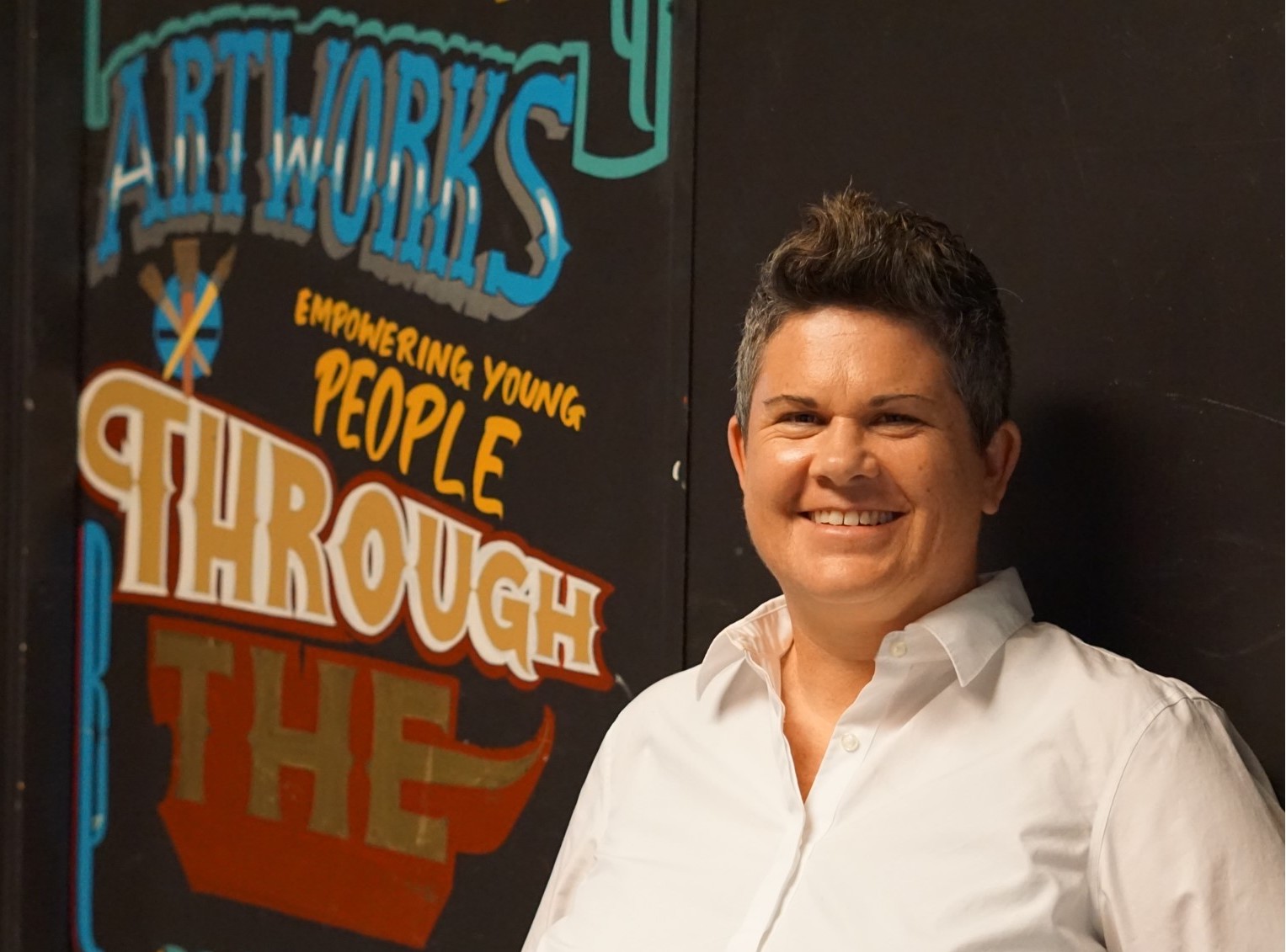Hi Amanda! Tell us about yourself and your background.
I’m originally from Kansas City, but have had the opportunity to live, study, and work in several arts for social change programs around the world. Teaching English for a year in Nicaragua right after college got me excited about experiencing life in other places. I did my graduate work at the University of Manchester in England, studying theater for development in Uganda and Burkina Faso. I’ve worked as a teaching artist, facilitator and administrator of arts programs for at-risk youth and other marginalized communities in Austin, Toronto, and Kansas City, before putting my roots down in Seattle a little over three years ago.
You’ve been in the Executive Director role for just over one month. How’s it going so far?
Whew! It’s been very busy, but exhilarating! I have been connecting with some of the amazing people and organizations Urban ArtWorks has worked with over the years, as well as making new connections. There are several projects in mid-flow, and I have been working with our new Projects Lead, Paul Nunn, to ensure we maintain the same high caliber of public art projects people have come to expect from us. In addition, I have been working on expanding our youth programs so we can share this transformative experience with even more youth in the coming years. Every single person on the Board of Directors has taken on an extra load the last few months to ensure my transition is as smooth as possible. Their commitment gives me confidence that Urban ArtWorks will continue to grow and prosper as one of the leading arts organizations for young people in Seattle.
What motivates you in your role?
I am most motivated by the knowledge that too often, young people are silenced, especially those who are not white, cis-gender, and middle-class. I have seen over and over the power of the arts to provide young people the opportunity to realize and express the powerful contributions they can make in our communities. The process of creating public art holds within it this almost magical potential for teens to see that they already possess perspectives which are not only worthy of sharing, but are also vital to creating a community that is healthy and beautiful. I want to create as many opportunities as I can for Seattle and beyond to “hear” our young people speak through their art.
What drew you to Urban ArtWorks in the first place?
A good portion of my career has been focused on arts programs for teens who are involved in the court system. Urban ArtWorks is one of just a few places for court-involved youth to access the arts. I was also drawn to the fact that our young people not only learn new art skills and express their voices, but they also learn job skills and are paid for their work, which is a positive and tangible impact on their lives.
What are your priorities for Urban ArtWorks in the months ahead? What are you excited about?
Being only a month in so far, I’m focusing a lot right now on getting a thorough understanding of our current programming and partnerships. I am looking forward to starting a strategic planning process towards the end of the year, working with our Board to assess where we are and where we want to go in the future. More than anything, I’m excited about developing new youth programs! I want to increase the number of youth we are serving in our studio year-round, as well as create more opportunities within schools. I’m dedicated to diversifying our Teaching Artist and Artist rosters so that many visions and voices are seen and heard, and our young people have the opportunity to be inspired by mentors with whom they can relate.
How do you see Urban ArtWorks changing under your leadership? What will stay the same?
Urban ArtWorks will still be the place to go to commission unique and well-designed murals! We will continue to provide paid arts opportunities for court-involved youth, with the intention of expanding the youth population we serve. I will be relying on my 20+ years experience of designing and facilitating youth arts programs to develop new and more intentional curricula that focuses on equity and social change in process and product.
What’s on the horizon for Urban ArtWorks this summer?
A lot! I’m excited to say that we will be doubling our youth programming this summer, with two youth sessions serving 25 teens- and we are hiring Teaching Artists to grow our team. We will also be in festival mode, creating interactive murals for Bumbershoot, Design in Public, and Festival Festival, to name a few! We are currently finishing up some really cool pieces at five different Starbucks locations, and we will be creating murals for Bellwether Housing and the new Lyft hub. We are also working on some very exciting incoming projects and partnerships that will be announced soon.
Tell us more about the youth programming you’ve worked on previously. How will you apply that experience to Urban ArtWorks?
The majority of my career has focused on facilitating programs for marginalized teens to work together to identify and prioritize issues in their lives, and to create public artwork that shares their perspectives with the wider community. This includes serving as Assistant Director for the Circle Playhouse in Toronto, where I worked with teens to write and perform original plays based on their experiences of being raised in foster care. At Creative Action, the largest Educational Arts organization for historically underserved youth in Central Texas, I was the director of The Changing Lives Youth Theatre Ensemble, a year-round program that employed teens to write and tour performances about healthy relationships and dating violence. While at Creative Action, I also started the New Stages: Arts Empowerment for Juvenile Offenders program. This was a 16-week program for youth in juvenile detention that focused on playwriting and spoken word performances.

In 2011, I founded CreativeWorks, a Kansas City based nonprofit that provided social justice-focused visual art, performance, and digital media programs for teens in detention and on probation. CreativeWorks’ programs offered teens the chance to name and voice their perspectives, see how their experiences connected to the larger community, and imagine a future where their experiences and wisdom would be valued. A couple examples of projects I worked on which are pertinent to Urban Artworks are Urban Canvas KC and Teens in Transition.
The Urban Canvas KC project was a partnership with the Kansas City Police Department. I worked with a group of teens who were employed to design murals that were then placed on doors and windows of abandoned houses. Through a cyclical process of brainstorming, design, and feedback, we created powerful murals that served to create safety and brighten a blighted neighborhood, while inspiring dialogue among viewers.
Teens In Transition was a collaboration between the KC Mayor, Jackson County Prosecutor, the FBI, and several KC social service and arts organizations. Started in 2014, this program offers summer employment to teens identified by the KC police as being the most at-risk for being either the perpetrators or victims of violent crime. Youth engaged in an arts-based curriculum and focused on developing social and employment skills. Each summer youth worked alongside school resource officers to design and install a mural that was located in a highly visible space in the community.
In each of these programs, youth had to work together to set and achieve a seemingly impossible goal such as writing and performing an original play in the span of just 10 weeks, with little-to-no writing or acting experience; or gang members working alongside police officers to establish a common vision for a mural to be shared with the community. The transformative power of the arts starts with the process of young people beginning to trust themselves enough to share their perspectives with those they are working with, and continues when their multiple perspectives are negotiated to define a shared artistic vision. Through the sharing of their voices with the public, a reciprocal transformation is possible. The community has the opportunity to see past the stereotypes they may have held, and see the young people as positive and necessary contributors to society. Young people then see themselves being seen in that way, which helps bolster their self-understanding and self-efficacy. Whether the teens go on to be involved in the arts or not, the experience often translates, and participants now know that they can achieve other goals they may set for themselves. I want to ensure we create a safe space in all of our programs at Urban ArtWorks, where this kind of transformation is intentional and possible.
You were introduced as the incoming Executive Director at Urban ArtWorks’ annual fundraiser, Brushed Up. What was that like?

Brushed Up was such a fun and beautiful way to meet the Urban ArtWorks family. I was blown away by the support of the community. I was deeply moved to hear Mari, one of our Teaching Artists, speak with Jada, one of our recent youth program participants. Their love and respect for one another was palpable, and that let me know that there is something potent and real happening in the programs. It was inspiring to hear Seattle’s Chief of Police, Carmen Best, talk about the impact our program is making on Seattle. I am looking forward to the next Brushed Up, when I will have had the opportunity to make more personal connections with everyone!
What would a dream Urban ArtWorks project be for you?
I must admit, it is challenging at times to keep my dreams in check, because there are so many unique and powerful possibilities! I would love to establish a similar program to Teens in Transition, as I described earlier. I envision a diversion program where Urban ArtWorks collaborates with the police and other social service organizations, to provide at-risk youth the opportunity to work alongside officers to create public art pieces. Social service providers could offer workshops on things such as budgeting, anger management, and college applications. I’d like to collaborate with some of the many organizations who are already doing such instrumental work in Seattle and see how we might increase our impact together. Let’s talk!
Anything else you’d like to add?
Just that it’s a privilege for me to be part of an organization that makes such a positive impact not only on young people, but also on the communities, organizations, and businesses where our artwork makes things a little more vibrant and thought-provoking. It’s work that brings joy and good things to many people, and I’m honored and excited to lead it into the future.


